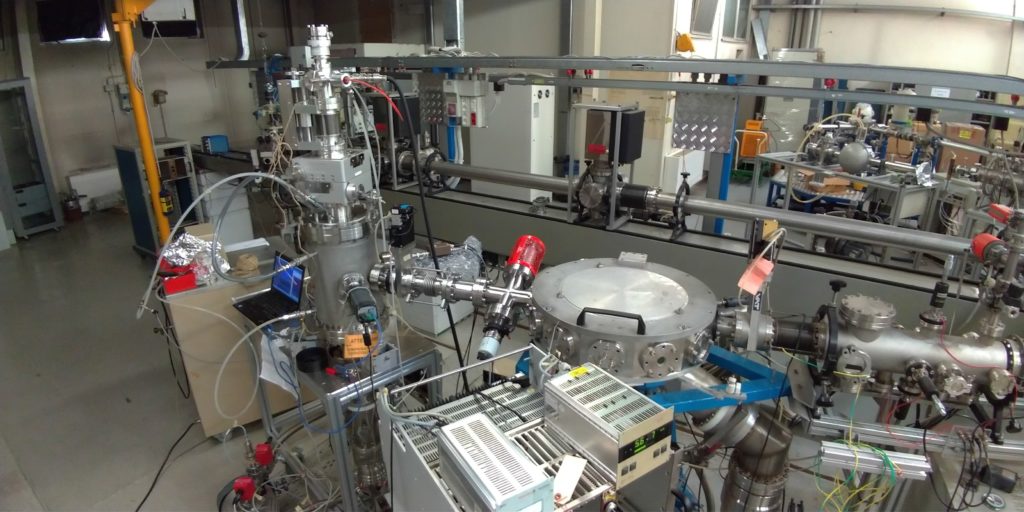Laboratory web pages:
University of Padua (external link)
University of Milan (external link)
Laboratori Nazionali di Legnaro, LNL (external link)
Legnaro National Laboratories (LNL) of INFN have longstanding experience in target production and characterization and have often provided targets for nuclear astrophysics experiments. Target production can be performed through evaporation [HRK15, PC21], ion implantation [PBC+10, DCF+15], HIVPP [SCP+20] and physical vapor deposition reactive sputtering [RCM+14]. On the other hand, different target characterization setups make use of Rutherford Backscattering Spectroscopy (RBS), Elastic Recoil Detection Analysis (ERDA) and Nuclear Reaction Analysis (NRA) [MN10]. In particular, two accelerator facilities are used for target characterization: AN2000 and CN. AN2000 is a 2 MV accelerator providing proton, 3He and 4He beams with currents up to 1 µA. CN is a 7 MV Van de Graaff accelerator providing beams of protons, deuterium, 3He and 4He (single and doubly charged) with beam currents ranging from tens of nA to ∼1 µA, depending on the beam type.

(Credit: UNIPD/INFN-LNL)
For what concerns target production and characterization for nuclear astrophysics, two experiments are currently active: HEAT (Hydrogen dEsorption from cArbon Targets) and SALVIA (Setup for AnaLysis with MeV accelerators of Isotopic tArgets and their preparation). The HEAT project aims at developing pure carbon targets for measurements of the cross section of the 12C+12C reaction. So far, one of the main limitations found by experiments aiming at measuring the 12C+12C cross section below 2.5 MeV is the presence of a strong beam induced background due to the interaction of the carbon beam with hydrogen and deuterium contamination inside the targets: 1H(12C,γ)13N, 2H(12C,pγ)13C and the two-step process 2H(12C, 2H)12C → 12C(2H,pγ)13C [ZDLS+18, MAB+18]. The goal of the HEAT experiment is to establish a reproducible technique for hydrogen desorption
from different types of carbon targets. A picture of the HEAT setup is shown in figure 1. It consists in a vacuum chamber with water-cooled walls. The camber is equipped with several ports at different angles to allow the installation of detectors for Ion Beam Analysis and ancillary equipment. The target holder includes a programmable heating device reaching temperatures as high as 1200◦C. The heater and the target are mounted on a set of actuators for motion along the X,Y,Z axes and azimuthal rotation.
With this configuration it is possible to apply different IBA techniques to measure the hydrogen content in carbon targets before and after the desorption process. In particular, at the moment the project uses ERDA with 4He beam, and NRA exploiting the 2H(3He,p)4He reaction. The two techniques provide complementary information and allow to probe different depths inside the target [RD20]. The types of targets investigated so far include natural graphite, HOPG and glassy carbon [RD21]. Desorption tests on tantalum backings have also been performed, and the setup could be used in the future for for different applications.
For what concerns target production ad characterization, a project called SALVIA (Setup for AnaLysis with MeV accelerators of Isotopic tArgets and their preparation) has been recently founded by INFN. The experimental setup includes a new scattering chamber with different ad-hoc designed devices such as cryogenic electron suppressor and polarized sample holder, which allow high resolution measurement of elastic cross sections. Furthermore, the new setup allows to perform a high quality EBS, ERDA and NRA analysis for a complete target characterization of targets used in several nuclear experiments. A second research field of SALVIA project is the production and characterization of high quality solid target used mainly in LUNA experiment at Gran Sasso National Laboratories, using mainly PVD magnetron sputtering techniques. Magnetron sputtering combines high coatings quality and good control on film stoichiometry and it has imposed itself both in the industrial and research fields. This technique allows to change coating properties (composition, density, residual stress, roughness, adhesion etc.) with specific process parameters setting, and it allows to obtain, in some cases, materials with very advanced properties. This technique can be useful for the synthesis of nuclear targets where the investigated material is a specific gas isotope. In the SALVIA project different PVD technologies are used to obtain high quality target, focusing on contaminants reduction and therefor the beam-induced background.
References
[DCF+15] Rosanna Depalo, Francesca Cavanna, Federico Ferraro, Alessandra Slemer, Tariq Al- Abdullah, Shavkat Akhmadaliev, Michael Anders, Daniel Bemmerer, Zolt´an Elekes, Giovanni Mattei, Stefan Reinicke, Konrad Schmidt, Carlo Scian, and Louis Wagner. Strengths of the resonances at 436, 479, 639, 661, and 1279 keV in the 22Ne(p,γ)23Na reaction. Phys.Rev.C, 92:045807, Oct 2015.
[FWS+17] M Febbraro, David Walter, SC Shadrick, SD Pain, KA Chipps, Cory Thornsberry, and Ezra Lesser. Improved technique for preparation of deuterated-polyethylene targets. Nuclear Instruments and Methods in Physics Research Section B: Beam Interactions with Materials and Atoms, 410:53–59, 2017.
[GR84] A Geuer-Richter. Preparazione di films sottili per esperimenti di fisica nucleare con acceleratori di particelle. Technical report, INFN, 1984.
[h20] Horizon2020 web page. https://ec.europa.eu/programmes/horizon2020/en/.
[HRK15] Hartmut Frey Hamid R. Khan. Handbook of Thin Film Technology. Springer Berlin Heidelberg, 2015.
[MAB+18] L. Morales-Gallegos, M. Aliotta, C. G. Bruno, R. Buompane, T. Davinson, M. De Cesare, A. Di Leva, A. D’Onofrio, J. G. Duarte, L. R. Gasques, L. Gialanella, G. Imbriani, G. Porzio, D. Rapagnani, M. Romoli, D. Schürmann, F. Terrasi, and L. Y. Zhang. Reduction of deuterium content in carbon targets for 12C + 12C reaction studies of astrophysical interest. European Physical Journal A, 54(8):132, August 2018.
[MN10] Yongqiang Wang Michael Nastasi. Handbook of Modern Ion Beam Materials Analysis. Materials Research Society, 2010.
[Mug87] AHF Muggleton. Deposition techniques for the preparation of thin film nuclear targets. Vacuum, 37(11-12):785–817, 1987.
[PBC+10] G. Perotto, V. Bello, T. Cesca, G. Mattei, P. Mazzoldi, G. Pellegrini, and C. Scian. Nano patterning of silica with mask-assisted ion implantation. Nuclear Instruments and Methods in Physics Research Section B: Beam Interactions with Materials and Atoms, 268(19):3211–3214, 2010. Radiation Effects in Insulators.
[PC21] L. Costa A. Gambalonga M. Loriggiola T. Marchi D. Rosso V. Volpe P. Cocconi, A. Cogo. User service. INFN-LNL Report, 262:216–217, 2021.
[RCM+14] W. Raniero, M. Campostrini, G. Maggioni, G. Della Mea, and A. Quaranta. Physical vapour deposition reactive magnetron sputtering for the production and application of dichroics in photovoltaic system with solar spectral splitting. Applied Surface Science, 308:170–175, 2014.
[RD20] C. Broggini M. Campostrini A. Guglielmetti E. Masha R. Menegazzo G. Montagnoli D. Piatti V. Rigato R. Depalo, A. Caciolli. The heat project: study of hydrogen desorption from carbon targets. INFN-LNL Report, 259:101–102, 2020.
[RD21] A. Caciolli C. Broggini M. Campostrini A. Guglielmetti E. Masha R. Menegazzo G. Mon- tagnoli J. Skowronski V. Rigato R. Depalo, D. Piatti. The heat project: study of hydrogen desorption from carbon targets. INFN-LNL Report, 262:97–98, 2021.
[SCP+20] Hanna Skliarova, Sara Cisternino, Lorenzo Pranovi, Liliana Mou, Gaia Pupillo, Valentino Rigato, and Carlos Rossi Alvarez. Hivipp deposition and characterization of isotopically enriched 48ti targets for nuclear cross-section measurements. Nuclear Instruments and Methods in Physics Research Section A: Accelerators, Spectrometers, Detectors and Associated Equipment, 981:164371, 2020.
[Ses12] Krishna Seshan. Handbook of thin film deposition. William Andrew, 2012.
[Tho75] D.M. Thompson. In 4th Int. Conf. Nuclear Target Development Soc., Argonne, Illinois, USA, 1975.
[ZDLS+18] J. Zickefoose, A. Di Leva, F. Strieder, L. Gialanella, G. Imbriani, N. De Cesare, C. Rolfs, J. Schweitzer, T. Spillane, O. Straniero, and F. Terrasi. Measurement of the 12C(12C,p)23Na cross section near the Gamow energy. Phys. Rev. C, 97:065806, Jun 2018.
